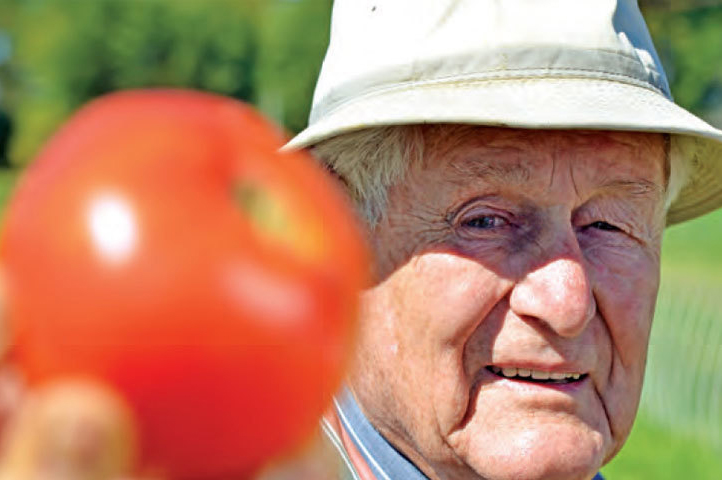
For more than half his life, Mannon Gallegly, West Virginia University professor emeritus of plant pathology, has been perfecting the tomato. In 1950, his research on vegetable diseases and tomato blight at WVU led him on a 13-year journey that culminated with the West Virginia ’63, also dubbed the “people’s tomato,” released in 1963 and rereleased in 2013 to help commemorate West Virginia’s 100th and 150th birthdays, respectively.
Now, with another birthday to celebrate –the 150th of the West Virginia University Davis College of Agriculture, Natural Resources and Design, the University’s founding academic unit – Gallegly is releasing two varieties of a new tomato in honor of the special occasion.
And, as if that wasn’t reason enough to celebrate, a limited number of people – 150, to be exact – will have the opportunity to plant, grow and taste the new tomato over the next few months.
Gallegly and Mahfuz Rahman, assistant professor and WVU Extension specialist in plant pathology, started developing the tomato varieties in 2013. Their goal was to develop a tomato not only resistant to late blight, but also tolerant to Septoria lycopersici, a fungus that causes Septoria leaf spot, a destructive disease of tomato foliage that can occur at any stage of plant development.
“Septoria lycopersici produces spots on the leaves and lesions on the stems,” Gallegly said. “The centers of these spots are gray or tan, and within those spots are tiny, microscopic bodies. When it rains, or when the dew forms at night, those bodies exude a substance containing jillions of sticky spores.”
Septoria leaf spot isn’t new. It’s been around for a long time, according to Gallegly, but it wasn’t severe enough to cause much worry.
“In fact, we kind of looked forward to it coming in during the late season so it would defoliate, and enable us to more easily pick tomatoes,” Gallegly said. “But now, it’s coming in early and knocking out the yield.”
Based on observation, Gallegly suspects the marmorated stink bug is to blame for the rise in Septoria leaf spot.
“The common stink bug has been with us a long time, but this new strain of the insect – the marmorated stink bug – was recently imported into the country, and the population has been high in recent years,” he said.
“These bugs love tomatoes,” Gallegly explained. “They’ll puncture it, feed on it, and leave little ghost-white rings on the fruit. They like to hide underneath the plants during the daytime – maybe so the birds won’t get them. Then, they come out at night and crawl around, spreading the sticky spores all over the leaves, stems and fruit.
“And wherever there’s a spore, it will germinate and form another spot.”
On Friday, March 24, Gallegly will unveil the new tomato varieties during the annual meeting of the Potomac Division of the American Phytopathological Society at Lakeview Resort and Spa in Morgantown. The event is open to the public.
The tomato varieties are currently being referred to as the “West Virginia ’17A” and “West Virginia ’17B.”
“The West Virginia ’17A is more prolific, producing more fruit,” Gallegly said. “It’s a firmer fruit that is less sweet than the West Virginia ’17B variety. The ’17B is more of a beefsteak type. It’s larger than ’17A and sweeter than both the ’17A and West Virginia ’63.”
To honor the 150th birthday of the WVU Davis College of Agriculture, Natural Resources and Design, the College will mail a seed packet of each variety to the first 150 people who request to participate as a grower and tester (limit one request per household). Participants are asked to grow, test and provide feedback on their results via a survey.
Growers may submit requests for seed packets via this online form. Seed packets will be mailed to the first 150 respondents beginning April 3.
Additionally, everyone is invited to help name the tomato via the online submission form. Deadline for submissions is August 1. A committee will select the top three to five submissions, then invite the public to vote on their favorite name. The winning name will be announced August 31.